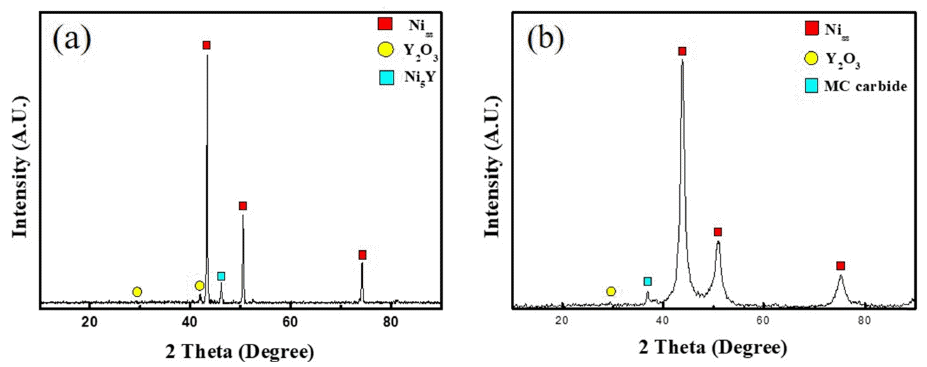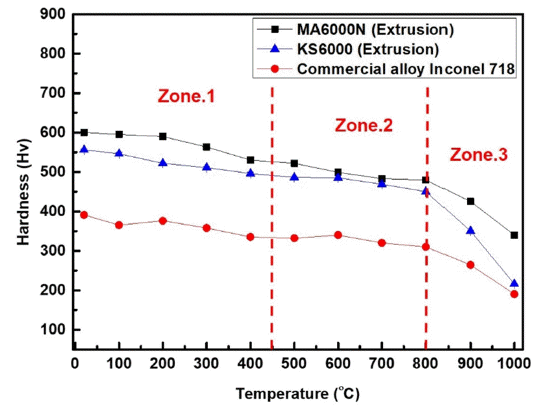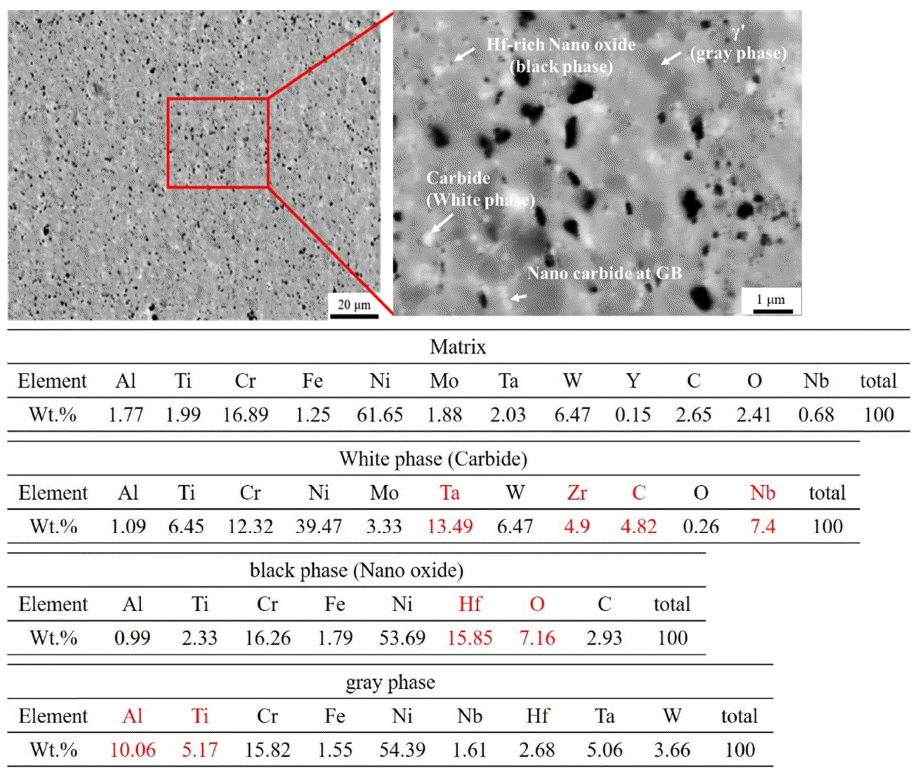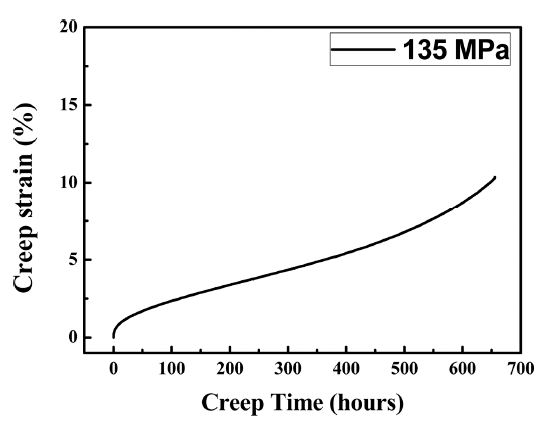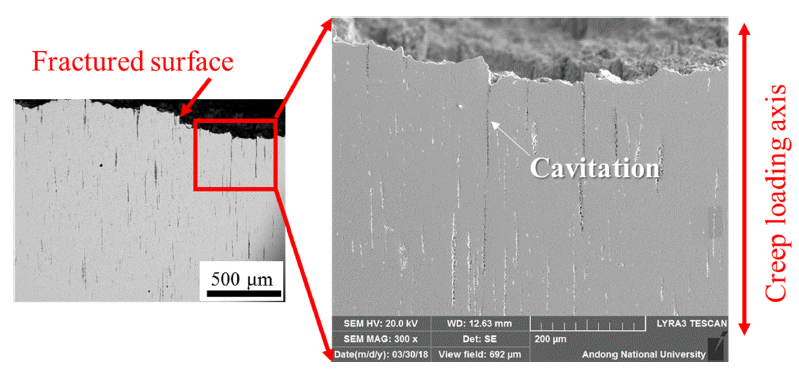Articles
- Page Path
- HOME > J Korean Powder Metall Inst > Volume 27(1); 2020 > Article
-
ARTICLE
- Effects of Precipitates and Oxide Dispersion on the High-temperature Mechanical Properties of ODS Ni-Based Superalloys
- GooWon Noha,b, Young Do Kimb, Kee-Ahn Leec, Hwi-Jun Kima,*
-
Journal of Korean Powder Metallurgy Institute 2020;27(1):8-13.
DOI: https://doi.org/10.4150/KPMI.2020.27.1.8
Published online: January 31, 2020
a Liquid processing & Casting R&D Group, Korea Institute of Industrial Technology, Incheon 406-840, Republic of Korea
b Department of Materials Science and Engineering, Hanyang University, Seoul 04763, Republic of Korea
c Department of Materials Science and Engineering, Inha University, Incheon 22212, Republic of Korea
- *Corresponding Author: Hwi-Jun Kim, TEL: +82-32-850-0406, FAX: +82-32-850-0390, E-mail: khj@kitech.re.kr
- - 노구원: 학생, 김영도·이기안: 교수, 김휘준: 수석연구원
© The Korean Powder Metallurgy Institute. All rights reserved.
- 1,649 Views
- 32 Download
- 2 Crossref
Abstract
- In this study, we investigated the effects of precipitates and oxide dispersoids on the high-temperature mechanical properties of oxide dispersion-strengthened (ODS) Ni-based super alloys. Two ODS Ni-based super alloy rods with different chemical compositions were fabricated by high-energy milling and hot extrusion process at 1150 °C to investigate the effects of precipitates on high-temperature mechanical properties. Further, the MA6000N alloy is an improvement over the commercial MA6000 alloy, and the KS6000 alloy has the same chemical composition as the MA6000 alloy. The phase and microstructure of Ni-based super alloys were investigated by X-ray diffraction and scanning electron microscopy. It was found that MC carbide precipitates and oxide dispersoids in the ODS Ni-based super alloys developed in this study may effectively improve high-temperature hardness and creep resistance.
- Oxide dispersion strengthened (ODS) Ni-based super alloys have higher available temperature and excellent high temperature properties compared to conventional super alloys [1, 2]. Therefore, various studies have been conducted on ODS Ni-based super alloys with excellent high-temperature characteristics for industrial fields such as aerospace, defense, and gas turbine applications. The oxide dispersion strengthening mechanism of various strengthening methods plays the most important role to provide superior strength and stability at elevated temperatures, since dispersed oxide particles interrupt movement of dislocation effectively at high temperature via the “Pinning effect” phenomenon. It is well known that the “Pinning effect” depends on the density and size of precipitates and oxide dispersoids [3].
- ODS Ni-based super alloys are commercially available as MA6000 and MA758 alloys. The chemical composition of MA6000 and MA758 alloys are Ni-15Cr-4.5Al- 2.5Ti-2Mo-4W-0.15Zr-1.1Y2O3 and Ni-30Cr-0.3Al-0.5Ti- 1.0Fe-0.05C-0.6Y2O3, respectively. Considering these general oxide dispersion strengthening mechanisms, the strengthening mechanism of Ni-based ODS alloys can be represented by the following three strengthening mechanisms: 1) solid solution hardening (γ-phase) by the high solubility of Cr in Ni (47 wt.% at 1618 K), 2) precipitation hardening by Ni3 (Al,Ti) precipitate (γ’-phase), and 3) dispersion hardening through the formation of oxide dispersoid- based Y-metal-O phase. An alloying method with a good combination of precipitation hardening and dispersion hardening was developed for the first time at the International Central Laboratory (INCO) in the United States by a mechanical alloying (MA) process [4]. The purpose of the MA process is to simultaneously alloy an oxide with a high melting point and a metal having a relatively lower melting point, which cannot be alloyed by the general melting process, and then to finely and uni- formly disperse stable oxides like Y2O3. After the MA process was developed, it utilized to manufacture an ODS alloy [5]. However, ODS alloying through the MA process has some disadvantages. First, the manufacturing time is extremely long, about 48 hours compared to other manufacturing processes. Secondly, since the MA process is alloyed by the collision between raw material powders and a ball having a metal or ceramic material, if the manufacturing time is long, the mechanical properties are adversely affected by contamination of the alloy powder depending on the ball materials [6].
- In this study, we designed an alloy by excluding additive elements, which have no solubility in Ni, and fabricated alloy powders by a gas atomization process. Through this study, we attempted to obtain a stable carbide and oxide at high temperature to improve the mechanical properties and minimize the disadvantages of ODS alloy manufacturing method using a conventional MA process. In addition, we propose a progressive liquid sintering (PLS) process, which is a new heat treatment method. The three-step heat treatments after hot extrusion must be performed in order to obtain the γ’- phase, which is the main hardening phase of Ni-based ODS alloys. However, this method also has a disadvantage that the manufacturing time is considerably long; the manufacturing time is reduced through the PLS process. The described method was effective at removing pores inside alloy material and suppress the diffusion of solute through the liquid phases having a partial melting state with a fraction of 20 % to 80 %. Therefore, we report on a new ODS alloy fabrication process, and discuss the effects of stable precipitates and dispersoids on the resulting high temperature properties at high temperatures.
1. Introduction
- ODS alloy powders were prepared by high-vacuum gas atomization (HVGA) in a vacuum atmosphere in order to investigate the variation of high temperature characteristics by chemical composition. The nominal chemical composition of the two alloys is shown in Table 1. The MA6000N alloy is an improved MA6000 alloy and the KS6000 alloy has the same chemical composition as the MA6000 alloy.
- The prepared ODS alloy powder was mechanically alloyed using a horizontal ball-mill apparatus (model: Simoloyer CM-20, GMBH, Germany). The ball milling conditions (MA) were as follows. 1) A SUS ball with a diameter of 5 mm was used. 2) The volume fraction of ball and powder was 10:1. 3) The Y2O3 powder was added to 0.5 wt. % of MA6000N and 1.1 wt. % of KS6000 to the alloy powders, respectively. 4) Mixed powders were mechanically alloyed for a total of nine hours in an oxygen atmosphere by repeating the two-step condition (first step: 480 RPM for 50 minutes, second step: 245 RPM for 10 minutes). Phase analysis was performed using XRD (model: X’ Pert-Pro MPD/PANalytical) to observe phase changes before and after MA. A steel can was prepared for hot extrusion of the milled powders. The milled powder was poured into the steel can and was degassed at 773 K for six hours under a high vacuum atmosphere. Subsequently, the can was extruded at an extrusion ratio of 16:1 at 1423 K. The extruded can is rod shaped with Φ 16. These rods were post-treated under an argon atmosphere at a moving speed of 70 mm/min at about 1473 K by the PLS method. The high temperature mechanical properties like hardness and tensile strength were measured up to 1253 K. The creep properties were evaluated at a stress of 135 MPa and creep temperature of 1253 K. After the creep tests, the microstructure was observed by field emission scanning electron microscopy (FESEM) and energy dispersive spectrometer (EDS) (TESCAN MIRA3).
2. Experimental procedure
- Figure 1 is the EPMA image of the MA6000N alloy manufactured by gas atomization. Figure 2 shows a typical secondary electron (SE) image with dendrite obtained from gas atomized metal powders. The Y, Hf, and W ele- ments in MA6000N powder were homogeneously distributed at the interdendritic regions by EDS mapping. On the powder surface, Y and O elements were observed to coexist, because Y has an exceptionally high affinity for oxygen.
- In the conventional MA process, a nano-sized Y2O3 with MA6000 alloy powder was added at 1.1 wt. %. However, the MA600N was milled by addition of a minute amount of 0.5 wt. %, because there is a Y2O3 layer on the surface. We utilized XRD to identify phase variation due to the addition of Y2O3 and MA results. Figure 2 shows the XRD results of MA6000N powder before (a) and after (b) ball milling (MA). The XRD result before ball milling indicated that the MA6000N alloy powder is composed of α-Ni, Y2O3, and Ni5Y phases. Therefore, when the EPMA and XRD results are compared, it can be seen that the surface oxide is Y2O3 and the internal phases are α-Ni and Ni5Y. The XRD result after ball milling showed a broad pattern and MC carbide phase. The MC carbide within a Ni-based super alloy tends to be degraded by M23C6 or M6C carbide during ball milling of heat treatment.
- Hardness variations of hot-extruded rods were investigated at various temperatures from room temperature to 1273 K after hot extrusion. Figure 3 displays the result of hardness variation for MA6000N and KS6000. As the measurement temperature increased, the hardness of both alloys decreased gradually. After 1073 K, the hardness dropped sharply from the previous zones [7-9]. In addition, the hardness of the MA6000N rod was higher than the KS6000 rod throughout all zones (zone 1, zone 2, and zone. 3). Dispersion strengthening affects mechanical properties at high temperatures due to particle size and type, spacing, and dispersion. It is also known that dispersoids, which were finely and homogeneously dispersed, play a role in improving mechanical properties at both room temperature and high temperature.
- Microstructure was observed to investigate the effect of these strengthening factors on MA6000N alloys. Figure 4 shows a back-scattering electron (BSE) image and the result of phase analysis using EDS of MA6000N rod heat-treated by PLS process. The matrix, gray, and black or white phases were identified as the α-Ni, γ’, and Hfrich oxides, M23C6 carbide precipitates respectively. The MC carbide phases presented after milling were found to be in the grain boundaries with fine M23C6 carbide. The fine M23C6 carbide effectively prevents the sliding of the grain boundary at high temperatures, so as the volume fraction of M23C6 carbide increases, the coarsening of the grain is prevented and the mechanical properties at high temperature are improved. The sharp decrease in hardness at 1273 K can be estimated for the following reasons [9-12]. The main strengthening phase (γ' phase with a face-centered cubic (FCC) crystal structure and coherent relationship with matrix) is greatly influenced by the mechanical properties at high temperature [13]. However, the hardness value is drastically reduced at temperatures above 1073 K, because the γ' phase is dissolved into the matrix.
- Figure 5 shows the creep test results of the MA6000N rod heat-treated by the PLS process. The sample finally failed after 650 hours at a constant load and temperature of 135 MPa and 1253 K, respectively. It is superior to the results reported in literatures tested at constant load and temperature of 230 MPa and 1253 K, respectively [14]. In addition, the Larson-miller index P1 of MA6000N at 1273 K was 3.3 × 104, and Mino, K. showed that P1 of Alloy98 alloy was 3 × 104 under the same experimental conditions. Samples of MA6000N are expected to break after 264.85 hours with 135 MPa stress at 1273 K and after 1.148 hours with Alloy98 alloy [15]. The improvement of creep resistance of the ODS alloys in the present study can be contributed by solid solution strengthening, precipitation hardening, dispersion strengthening, directionally grain growth by secondary recrystallization by preventing intergranular slip, and minimizing transverse rupture. Figure 6 shows the EBSD results of a MA6000 rod heat-treated by the PLS process. It was confirmed that the grains did not directionally grow and had a random orientation relationship.
- Therefore, it can be seen that our sample depends on the mechanical properties only by γ' precipitate and carbide- based dispersoid. However, the volume fraction of γ'-phase in commercial alloys, INCO MA6000, is about 55%, while the MA6000N alloy is considerably less at about 7.66% (Table 2).
- Thus, the hardening result of MA6000N alloys is expected to be due to the dispersion strengthening mechanism via the insoluble second phase, such as Hf-oxides, nano-sized M23C6 carbide, rather than the γ'-phase in Zone 3 (Table 3).
- The cavitation fraction tends to increase in the region close to the fractured surface. However, the fracture features were intergranular with no specific direction, unlike the trans-granular fracture where the crack propagates in the 45° direction. In other words, the MA6000N alloy has a creep similar to that of INCO MA6000 alloy, which is a commercially available alloy, because it prevents grain boundary sliding due to Hf-based oxide dispersoids and M23C6 carbide, which are finely present in grain boundaries despite the intergranular fracture. The mechanism for creep characteristics needs further analysis and will be reported in subsequent investigations.
3. Results and Discussion
A cross-sectional SEM image and the corresponding EPMA elemental maps of MA6000N atomized powder.
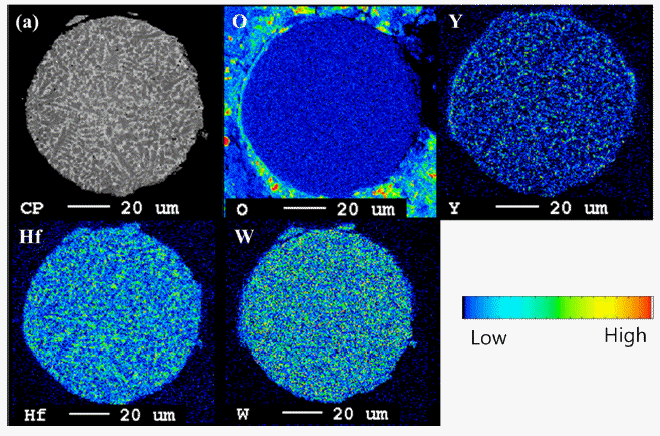
The statistical area fractions and the average sizes of dispersoids and precipitates in the grain interior and along the grain boundaries

|
-
1) In this study, we proposed a new alloy system and process with similar performance to the conventional ODS alloys while reducing the milling time and increasing productivity.
2) The main hardening mechanisms were dispersion hardening by γ'-phase and carbide-based M23C6 carbide. Both phases were high in brittleness, so the existing 48-hour milling time could be shortened to nine hours.
3) The tertiary creep before creep rupture was rapidly deformed, and then fractured because the fraction of work hardening is larger than the recovery, unlike the secondary creep, and the vacancy increases rapidly at higher temperatures. The effect of Hf-oxides and M23C6 carbide on mechanical properties is greater than γ'-phase in our alloy system. Therefore, it is expected that the volume fraction of the γ'-phase dissolved in the matrix is less than other commercial alloy systems and the creep characteristics are excellent.
4. Conclusion
- 1. W. Betteridge and J. Heslop: Nimonic Alloys and Other Nickel-base High Temperature Alloys 2nd ed., J. Heslop (Ed.), Originating Research Org., United Kingdom, (1974). .
- 2. J. H. Kim and J. H. Lee: J. Korean Powder Metall. Inst., 20 (2013) 228. .
- 3. A. Chauhan, D. Litvinov, Y. de Carlan and J. Aktaa: Mater. Sci. Eng. A, 658 (2016) 123. .Article
- 4. J. S. Benjamin: Sci. Am., 234 (1976) 40. .Article
- 5. J. B. Seol, D. Haley, D. T. Hoelzer and J. H. Kim: Acta Mater., 153 (2018) 71. .Article
- 6. C. Suryanarayana: Prog. Mater. Sci., 46 (2001) 1. .Article
- 7. K. Kusnomi, K. Sumino, Y. Kawasaki and M. Yamazaki: Metall. Trans. A, 21 (1990) 547. .Article
- 8. J. Rösler and E. Arzt: Acta Metall. Mater., 38 (1990) 671. .Article
- 9. J. Yang, Q. Zheng, H. Zhang, X. Sun, H. Guan and Z. Hu: Mater. Sci. Eng. A, 527 (2010) 1016. .Article
- 10. J. Yang, Q. Zheng, X. Sun, H. Guan and Z. Hu: Mater. Sci. Eng. A, 429 (2006) 341. .Article
- 11. J. Smialek and G. M. Meier, Superalloys II, C. T. Sims, N. S. Stoloff and W. C. Hagel (Ed.), John Wiley & Sons, New York (1987) 293. .
- 12. B. G. Choi, I. S. Kim, D. H. Kim and C. Y. Jo: Mater. Sci. Eng. A, 478 (2008) 329. .Article
- 13. J. H. Choi, K. R. Lee, C. Y. Jo and I. B. Kim: J. Kor. Soc. Heat Treat., 5 (1992) 85. .
- 14. S. K. Kang and R. C. Benn: Metall. Trans. A, 16 (1985) 1285. .Article
- 15. K. Mino: J. Eng. Gas Turbines Power, 113 (1991) 568. .Article
Figure & Data
References
Citations

- Mechanical Properties and Residual Stress Analysis of ODS Ni Superalloy Fabricated by Laser Powder Bed Fusion Process
Dong Wan Lee, Su Gwan Lee, Cong Dhin Van, Cae Ryeong Kim, Jin Chun Kim, Hwi Jun Kim, Joong Gyeong Lim, Tae Sik Yoon
Journal of the Japan Society of Powder and Powder Metallurgy.2025; 72(Supplement): S453. CrossRef - Additive manufacturing of oxide-dispersion strengthened alloys: Materials, synthesis and manufacturing
Markus B. Wilms, Silja-Katharina Rittinghaus, Mareen Goßling, Bilal Gökce
Progress in Materials Science.2023; 133: 101049. CrossRef
-
 Cite this Article
Cite this Article
- Cite this Article
-
- Close
- Download Citation
- Close
- Figure
- Related articles
-
- The Effect of Aluminum Powder Size on the Structure and Mechanical Properties of Foam
- Effect of Hatch Spacing on the Microstructure and Mechanical Properties of SA508 Gr.3 Steel Fabricated by Laser Powder Bed Fusion
- Effect of the Cross-rolling Process on the Microstructures and Mechanical Properties of 9Cr-1W ODS Steel
- Effect of Calcium Addition on the High-Temperature Recovery of Nd and Dy from Nd-Fe-B Scrap Using Mg-Based Extractants
- Effect of WC Particle Size on the Microstructure, Mechanical and Electrical Properties of Ag/WC Sintered Electrical Contact Material





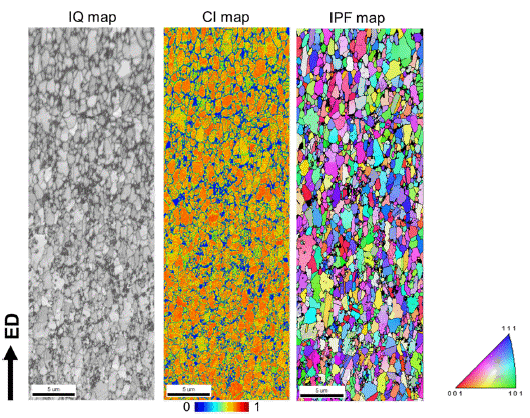

Fig. 1
Fig. 2
Fig. 3
Fig. 4
Fig. 5
Fig. 6
Fig. 7
Table 1
Table 2
Table 3
TOP
 KPMI
KPMI


